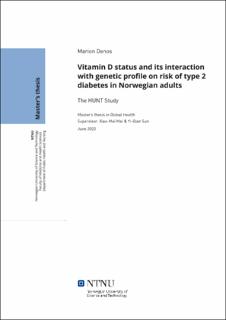| dc.description.abstract | Objective: The aim of the study was to investigate the relationship between serum 25-hydroxyvitamin D [25(OH)D] level and risk of type 2 diabetes mellitus (T2DM) in adults participating in the Nord-Trøndelag Health Study (HUNT) over 11 years of follow-up. We also evaluated if sex, body mass index (BMI) and genetic profile for T2DM had potential interactions with low vitamin D levels on the risk of T2DM.
Introduction: With more than 400 million people affected globally, diabetes has been identified by the United Nations as one of the four high priority non-communicable diseases targeted for action. Meanwhile, low vitamin D status remains a potential threat to health globally and has been associated with many diseases. However, its potential harmful effect on risk of diabetes is inconclusive.
Methods: This prospective cohort study included 3 586 diabetes-free adults at baseline. They were ≥19 years of age and participated in the second and third surveys of the Nord-Trøndelag Health Study [HUNT2 (1995-1997), defined as the baseline, and HUNT3 (2006-2008)] in Norway. Serum 25(OH)D levels were determined at baseline and classified as <50 nmol/L and ≥50 nmol/L. Comprehensive lifestyle and sociodemographic data were collected at baseline. A polygenic risk score (PRS) for T2DM based on 14 single-nucleotide polymorphisms (SNPs) was generated. Incident diabetes was defined by self-reporting of diabetes and/or non-fasting glucose levels greater than 11 mmol/L and serum glutamic acid decarboxylase antibodies (GADA) level lower than 0.08 ai at the follow-up in HUNT3. Odds ratios (ORs) with 95% confidence intervals (CI) for the association of baseline 25(OH)D level with risk of T2DM were evaluated using multivariable logistic regression models. We estimated effect modification by sex, BMI and PRS for diabetes for the risk of T2DM. Biological interaction of low serum 25(OH)D and high PRS for risk of T2DM was also evaluated. Multiple imputation was used to address possible bias due to missing data of the covariates.
Results: Over the follow-up period, a total of 104 (2.9%) participants developed T2DM. A higher risk of incident T2DM seemed to be present but not statistically significant in participants with serum 25(OH)D level under 50 nmol/L compared to those with serum 25(OH)D level above 50 nmol/L (OR=1.55, 95% CI=0.97-2.49). We used the top one third PRS as the cut-off value to study statistical interaction between serum 25(OH)D and PRS. Level of 25(OH)D under 50 nmol/L was associated with a significant increased risk of T2DM in the higher PRS group (OR=2.98, 95% CI=1.19-7.45). There was no effect modification by sex and BMI. We also found a biological interaction of low serum 25(OH)D and high PRS for the risk of T2DM.
Conclusion: Low serum 25(OH)D was associated with an increased risk of T2DM in Norwegian adults. The inverse association appeared particularly significant for people with high polygenic risk score for T2DM. Given the high prevalence of vitamin D insufficiency and T2DM worldwide, our study provided insights into new ways to prevent T2DM, particularly by incorporating the genetic factor of the disease with modifiable factors in prevention. | |
